HTML
--> --> -->To maintain an optimal radioisotope production database, the addition of new, reliable experimental data is always important [7]. Previous studies were conducted in the giant dipole resonance (GDR) energy region for the production of 115mCd [8] and 111mCd [8, 9] using a γ-ray spectrometry technique; however, the [8, 9] results were higher than the estimated values. No further literature data have been found for any of the nuclides of interest, even in the GDR region. In a nuclear reaction, daughter products may have ground and meta-stable states with different nuclear spins. The ratio between the reaction cross sections of isomers with high spin
Based on these data, in this study, well-established radiation activation and off-line γ-ray spectrometrywere employed to determine the nuclear reaction cross-sections and integral yields of the 115g,m,111m,109,107,105,104Cd and 113g,112,111g,110mAg radionuclides produced from natCd with the bremsstrahlung end-point energies of 50 and 60 MeV. The IR of 115m,gCd produced in the natCd(γ, n) reactions was also measured using the activation technique with these bremsstrahlung end-point energies. For comparison, the natCd(γ, xn)115g,m,111m,109,107,105,104Cd and natCd(γ, pxn)113g,112,111g,110mAg reaction cross sections were also theoretically calculated by employing the computer codes TALYS-1.95 [17] and EMPIRE-3.2 Malta [18]. The IR values from the present study with the bremsstrahlung end-point energies of 50 and 60 MeV are compared with the calculated values [17, 18] as well as with the available literature data [11-15].
The samples irradiated by the bremsstrahlung radiation with end-point energies of 50 and 60 MeV were taken out after sufficient cooling time. The off-line γ-ray counting was performed using a pre-calibrated HPGe detector coupled with a PC-based 4K channel analyzer. The HPGe detector used for γ-ray counting is an Ortec detector from Canberra. The dead time of the detector during the γ-ray counting was kept below 2% by changing the distance between the detector and irradiated samples; this prevented pile up and coincidence-summing effects. The resolution of the HPGe detector was 1.8 keV at full-width at half width (FWHM) at the photopeak of 1332.5 keV γ-ray of 60Co. The total detector efficiency was 20% at the 1332.5 keV γ-ray peak relative to a 7.62 cm × 7.62 cm NaI(Tl) detector. Typical γ-ray spectra of the reaction products produced from the natCd and 197Au monitor samples irradiated with bremsstrahlung radiation with an end-point energy of 60 MeV are shown in Fig. 1(a-c). The produced radionuclides were identified based on the respective γ-ray energies and half-lives of the radioactive isotopes [21, 22], as presented in Table 1.
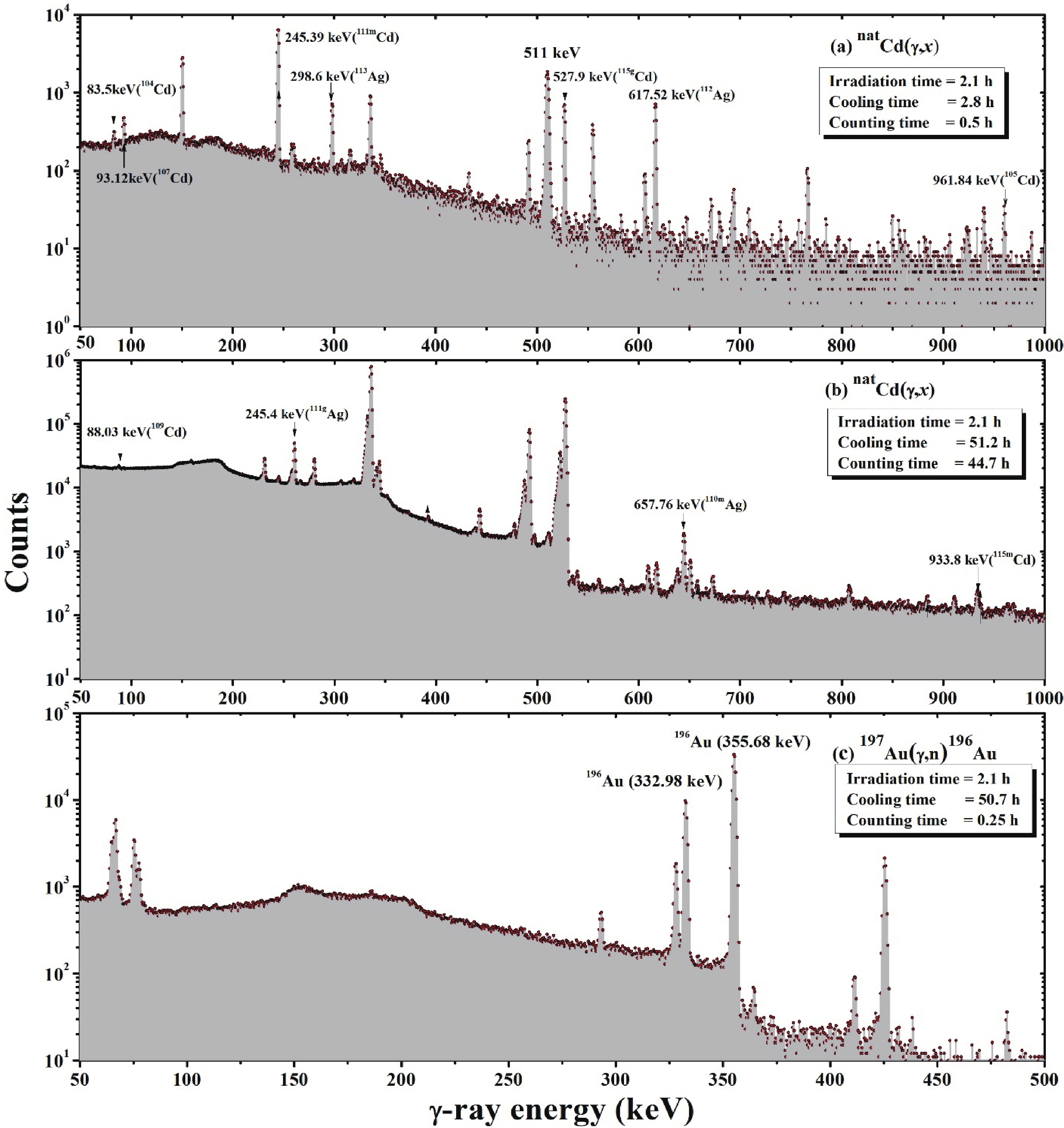 Figure1. (color online) Typical γ-ray spectra of the products of the natCd(γ, x) reactions with cooling times of (a) 2.8 h and (b) 51.2 h, and (c) those of the 197Au(g, n) reaction with a cooling time of 50.7 h. The bremsstrahlung end-point energy used for the irradiation was 60 MeV.
Figure1. (color online) Typical γ-ray spectra of the products of the natCd(γ, x) reactions with cooling times of (a) 2.8 h and (b) 51.2 h, and (c) those of the 197Au(g, n) reaction with a cooling time of 50.7 h. The bremsstrahlung end-point energy used for the irradiation was 60 MeV.| Nuclides (spin & parity) | Half-life | Decay mode (%) | g-ray energy /keV | γ-ray abundance (%) | Reactions | Q-value /MeV | Threshold /MeV |
| 115gCd (1/2)+ | 53.46 h | β- : 100.00 | 336.24 | 45.9 | 116Cd(γ, n) | ?8.699 | 8.700 |
| Decay of 115mAg (T1/2 = 18 s) by β-(79%) | |||||||
| 527.90 | 27.45 | Decay of 115gAg (T1/2 = 20 m) by β-(100%) | |||||
| 115mCd (11/2)- | 44.56 d | β-: 100.00 | 158.03 | 0.02 | 116Cd(γ, n) | ?8.699 | 8.700 |
| 484.47 | 0.29 | Decay of 115Ag (T1/2 = 20 m) by β-(100%) | |||||
| 933.80 | 2 | ||||||
| 111mCd (11/2)- | 48.5 m | IT : 100 | 150.82 | 29.1 | 111Cd(γ, g’) | 0.0 | 0.0 |
| 112Cd(γ, n) | ?9.394 | 9.394 | |||||
| 113Cd(γ, 2n) | ?15.934 | 15.935 | |||||
| 245.39 | 94 | 114Cd(γ, 3n) | ?24.977 | 24.980 | |||
| 116Cd(γ, 5n) | ?39.817 | 39.824 | |||||
| 109Cd (5/2)+ | 461.9 d | EC: 100 | 88.03 | 3.64 | 110Cd(γ, n) | ?9.915 | 9.915 |
| 111Cd(γ, 2n) | ?16.891 | 16.892 | |||||
| 112Cd(γ, 3n) | ?26.285 | 26.288 | |||||
| 113Cd(γ, 4n) | ?32.824 | 32.829 | |||||
| 114Cd(γ, 5n) | ?41.867 | 41.875 | |||||
| 116Cd(γ,7n) | ?56.707 | 56.722 | |||||
| 107Cd (5/2)+ | 6.5 h | EC :100 | 93.12 | 4.7 | 108Cd(γ, n) | ?10.334 | 10.334 |
| 110Cd(γ, 3n) | ?27.572 | 27.575 | |||||
| 111Cd(γ, 4n) | ?34.547 | 34.553 | |||||
| 112Cd(γ, 5n) | ?43.941 | 43.950 | |||||
| 828.93 | 0.163 | 113Cd(γ, 6n) | ?50.481 | 50.493 | |||
| 114Cd(γ, 7n) | ?59.524 | 59.541 | |||||
| 116Cd(γ, 9n) | ?74.364 | 74.390 | |||||
| 105Cd (5/2)+ | 55.5 m | EC :100 | 346.87 | 4.2 | 106Cd(γ, n) | ?10.870 | 10.870 |
| 108Cd(γ, 3n) | ?29.133 | 29.137 | |||||
| 433.24 | 2.81 | 110Cd(γ, 5n) | ?46.371 | 46.381 | |||
| 111Cd(γ, 6n) | ?53.346 | 53.360 | |||||
| 961.84 | 4.7 | 112Cd(γ, 7n) | ?62.740 | 62.759 | |||
| 113Cd(γ, 8n) | ?69.280 | 69.303 | |||||
| 104Cd (0)+ | 57.7 m | EC :100 | 106Cd(γ, 2n) | ?19.306 | 19.308 | ||
| 66.6 | 2.4 | 108Cd(γ, 4n) | ?37.569 | 37.576 | |||
| 83.5 | 47 | 110Cd(γ, 6n) | ?54.808 | 54.822 | |||
| 709.3 | 19.5 | 111Cd(γ, 7n) | ?61.783 | 61.802 | |||
| 112Cd(γ, 8n) | ?71.177 | 71.201 | |||||
| 113gAg (1/2)- | 5.37 h | β- : 100.00 | 258.72 | 1.64 | 114Cd(γ, p) | ?10.277 | 10.278 |
| 116Cd(γ, p2n) | ?25.117 | 25.120 | |||||
| 298.6 | 10 | Decay of 113mAg | |||||
| (T1/2 = 62 s, spin=7/2+) by IT(64%) | |||||||
| Continued on next page | |||||||
Table1.Nuclear spectroscopic data of the products of the natCd(γ, xn), natCd(γ, pxn), and 197Au(γ, n) reactions. The photo-peak activities of γ-ray energies marked with bold letters were used for calculations.
A.Determination of photon flux
The photon fluxes ( Figure2. (color online) Typical bremsstrahlung spectra for the end-point energies of 50 and 60 MeV simulated using the GEANT4 code.
Figure2. (color online) Typical bremsstrahlung spectra for the end-point energies of 50 and 60 MeV simulated using the GEANT4 code. $\Phi \left( {{E_{\rm e}}} \right) = \frac{{N_{\rm obs}^{{E_{\rm e}}}\left( {CL/LT} \right)\lambda }}{{n\left\langle {{{\rm{\sigma}} _R}\left( {{E_{\rm e}}} \right)} \right\rangle {I_\gamma }{{\rm{\varepsilon}} _\gamma }\left( {1 - {{\rm e}^{ - \lambda {T_{\rm irr}}}}} \right){{\rm e}^{ - \lambda {T_{\rm C}}}}\left( {1 - {{\rm e}^{ - \lambda CL}}} \right)}},$ | (1) |
| Table 1-continued from previous | |||||||
| Nuclides (spin & parity) | Half-life | Decay mode (%) | g-ray energy /keV | γ-ray abundance (%) | Reactions | Q-value /MeV | Threshold /MeV |
| 112Ag (2)- | 3.13 h | β- : 100.00 | 606.82 | 3.1 | 113Cd(γ, p) | ?9.749 | 9.749 |
| 617.52 | 43 | 114Cd(γ, pn) | ?18.792 | 18.793 | |||
| 694.87 | 2.9 | 116Cd(γ, p3n) | ?33.632 | 33.637 | |||
| 111gAg (1/2)- | 7.45 d | β- : 100.00 | 245.40 | 1.24 | 112Cd(γ, p) | ?9.648 | 9.649 |
| 113Cd(γ, pn) | ?16.188 | 16.189 | |||||
| 114Cd(γ, p2n) | ?25.231 | 25.234 | |||||
| 342.13 | 7 | 116Cd(γ, p4n) | ?40.071 | 40.079 | |||
| Decay of 111mAg (T1/2 = 1.08 m, spin=7/2+) by IT (99.3%) | |||||||
| 110mAg (6)+ | 249.83 d | IT : 1.33 | 657.76 | 95.61 | 111Cd(γ, p) | ?9.084 | 9.084 |
| 112Cd(γ, pn) | ?18.478 | 18.479 | |||||
| 113Cd(γ, p2n) | ?25.018 | 25.021 | |||||
| β- : 98.67 | 884.67 | 75 | 114Cd(γ, p3n) | ?34.061 | 34.066 | ||
| 116Cd(γ, p5n) | ?48.901 | 48.912 | |||||
| 196gAu (2)- | 6.18 d | EC : 92.8 β- : 7.2 | 355.68 | 87.0 | 197Au(γ, n) | ?8.072 | 8.073 |
2
B.Calculation of normalized yield and correction factor
Natural cadmium has eight stable isotopes with different isotopic abundances. The yield of the produced radionuclides is the sum of the isotope contributions based on their production threshold energies, as shown in Table 1. The eleven radio nuclides in Table 1 can be produced from natCd(γ, x)j reactions with different threshold values. The normalized yield contribution ( ${Y_{i,j}}\left( {{E_{\rm e}}} \right) = \frac{{\displaystyle\int_{{E_{\rm th}}}^{{E_{\rm e}}} {{A_i}\;{{\rm{\sigma}} _{i,j}}\left( {{E_\gamma }} \right){\rm{\phi}} \left( {{E_\gamma }} \right){\rm d}{E_\gamma }} }}{{\displaystyle\sum\limits_{k = 1}^8 {\int_{{E_{\rm th}}}^{{E_{\rm e}}} {{A_k}\;{{\rm{\sigma}} _{k,j}}\left( {{E_\gamma }} \right){\rm{\phi}} \left( {{E_\gamma }} \right){\rm d}{E_\gamma }} } }},$ | (2) |
| Produced Nuclei | Reaction | Eth/MeV | E e =50 MeV | Ee =60 MeV | |||
  |   |   |   | ||||
| 115gCd | 116Cd(γ, n) | 8.70 | Y116,115= 100 | F116,115= 0.934 | Y116,115 = 100 | F116,115= 0.940 | |
| 115mCd | 116Cd(γ, n) | 8.70 | Y116,115= 100 | F116,115= 0.934 | Y116,115 = 100 | F116,115= 0.940 | |
| 111mCd | 111Cd(γ, g’) | 0.0 | Y111,111= 1.70 | F111,111= 2.910 | Y111,111 =1.40 | F111,111= 2.710 | |
| 112Cd(γ, n) | 9.39 | Y112,111= 64.9 | F112,111= 0.890 | Y112,111=62.6 | F112,111= 0.901 | ||
| 113Cd(γ, 2n) | 15.94 | Y113,111= 18.5 | F113,111= 0.554 | Y113,111= 19.0 | F113,111= 0.592 | ||
| 114Cd(γ, 3n) | 24.96 | Y114,111= 14.5 | F114,111= 0.306 | Y114,111= 16.0 | F114,111= 0.359 | ||
| 116Cd(γ, 5n) | 39.82 | Y116,111= 0.40 | F116,111= 0.080 | Y116,111= 1.00 | F116,111= 0.148 | ||
| 109Cd | 110Cd(γ, n) | 9.92 | Y110,109= 75.7 | F110,109= 0.848 | Y110,109= 74.1 | F110,109= 0.863 | |
| 111Cd(γ, 2n) | 16.89 | Y111,109= 18.7 | F111,109= 0.518 | Y111,109= 18.7 | F111,109= 0.560 | ||
| 112Cd(γ, 3n) | 26.29 | Y112,109= 4.60 | F112,109= 0.278 | Y112,109= 5.00 | F112,109= 0.333 | ||
| 113Cd(γ, 4n) | 32.83 | Y113,109= 0.80 | F113,109= 0.168 | Y113,109= 1.10 | F113,109= 0.231 | ||
| 114Cd(γ, 5n) | 41.86 | Y114,109= 0.20 | F114,109= 0.059 | Y114,109= 1.10 | F114,109= 0.127 | ||
| 107Cd | 108Cd(γ, n) | 10.33 | Y108,107= 67.5 | F108,107= 0.823 | Y108,107= 59.2 | F108,107= 0.840 | |
| 110Cd(γ, 3n) | 27.58 | Y110,107= 24.7 | F110,107= 0.255 | Y110,107= 24.5 | F110,107= 0.316 | ||
| 111Cd(γ, 4n) | 34.55 | Y111,107= 7.30 | F111,107= 0.145 | Y111,107= 10.1 | F111,107= 0.210 | ||
| 112Cd(γ, 5n) | 43.95 | Y112,107= 0.50 | F112,107= 0.039 | Y112,107= 5.80 | F112,107= 0.108 | ||
| 113Cd(γ, 6n) | 50.49 | Y113,107= 0.00 | F113,107= 0.00 | Y113,107= 0.40 | F113,107= 0.052 | ||
| 105Cd | 106Cd(γ, n) | 10.87 | Y106,105= 98.6 | F106,105= 0.786 | Y106,105= 96.4 | F106,105= 0.806 | |
| 108Cd(γ, 3n) | 29.14 | Y108,105= 1.40 | F108,105= 0.227 | Y108,105= 1.60 | F108,105= 0.286 | ||
| 110Cd(γ, 5n) | 46.38 | Y110,105= 0.00 | F110,105= 0.020 | Y110,105= 1.90 | F110,105= 0.086 | ||
| 111Cd(γ, 6n) | 53.36 | Y111,105= 0.00 | F111,105= 0.000 | Y110,105= 0.10 | F111,105= 0.033 | ||
| 104Cd | 106Cd(γ, 2n) | 19.31 | Y106,104= 98.2 | F106,104= 0.443 | Y106,104= 96.2 | F106,104= 0.488 | |
| 108Cd(γ, 4n) | 37.58 | Y108,104= 1.80 | F108,104= 0.107 | Y108,104= 3.60 | F108,104= 0.174 | ||
| 110Cd(γ, 6n) | 54.82 | Y110,104= 0.00 | F110,104= 0.000 | Y110,104= 0.20 | F110,104= 0.016 | ||
| 113Ag | 114Cd(γ, p) | 10.28 | Y114,113= 88.1 | F114,113= 0.823 | Y114,113= 92.9 | F114,113= 0.840 | |
| 116Cd(γ, p2n) | 25.12 | Y116,113= 11.9 | F116,113= 0.302 | Y116,113= 7.10 | F116,113= 0.356 | ||
| 112Ag | 113Cd(γ, p) | 9.75 | Y113,112= 27.0 | F113,112= 0.862 | Y113,112= 21.9 | F113,112= 0.875 | |
| 114Cd(γ, pn) | 18.79 | Y114,112= 71.8 | F114,112= 0.460 | Y114,112= 74.3 | F114,112= 0.505 | ||
| 116Cd(γ, p3n) | 33.64 | Y116,112= 1.20 | F116,112= 0.156 | Y116,112= 3.80 | F116,112= 0.234 | ||
| 111Ag | 112Cd(γ, p) | 9.65 | Y112,111= 56.9 | F112,111= 0.862 | Y112,111= 49.9 | F112,111= 0.875 | |
| 113Cd(γ, pn) | 16.19 | Y113,111= 23.1 | F113,111= 0.546 | Y113,111= 23.0 | F113,111= 0.585 | ||
| 114Cd(γ, p2n) | 25.23 | Y114,111= 19.9 | F114,111= 0.297 | Y114,111= 26.5 | F114,111= 0.352 | ||
| 116Cd(γ, p4n) | 40.08 | Y116,111= 0.10 | F116,111= 0.078 | Y116,111= 0.60 | F116,111= 0.146 | ||
| 110mAg | 111Cd(γ, p) | 9.08 | Y111,110= 17.5 | F111,110= 0.905 | Y111,110= 10.7 | F111,110= 0.914 | |
| 112Cd(γ, pn) | 18.48 | Y112,110= 58.7 | F112,110= 0.466 | Y112,110= 49.2 | F112,110= 0.511 | ||
| 113Cd(γ, p2n) | 25.02 | Y113,110= 16.4 | F113,110= 0.301 | Y113,110= 18.3 | F113,110= 0.356 | ||
| 114Cd(γ, p3n) | 34.06 | Y114,110= 7.40 | F114,110= 0.151 | Y114,110= 21.6 | F114,110= 0.215 | ||
| 116Cd(γ, p5n) | 48.91 | Y116,110= 0.00 | F116,110= 0.004 | Y116,110= 0.20 | F116,110= 0.065 | ||
Table2.Normalized yield (%) and photon flux correction factor (
The threshold value (Eth) of the monitor reaction 197Au(γ, n)196Au is 8.07 MeV, as seen in Table 1. However, the production thresholds for the elevenradionuclides (j =115g,m;111m;109m,107m;105m;104mCd and 113g;112;111g;110mAg) are different from the monitor reaction as listed in Table 1. Therefore, a flux correction factor is required to correct the measured photon flux from the iCd(γ, x)j reactions to that from the monitor reaction. The photon flux correction factors
${F_{i,j}}\left( {{E_{\rm e}}} \right) = {{\int\limits_{E_{\rm th}^{i,j}}^{{E_{\rm e}}} {{\rm{\phi}} \left( {{E_\gamma }} \right){\rm d}{E_\gamma }} } \Big/ {\int\limits_{E_{\rm th}^{\rm Au}}^{{E_{\rm e}}} {{\rm{\phi}} \left( {{E_\gamma }} \right){\rm d}{E_\gamma }} }},$ | (3) |
The yield-weighted flux correction factors
$C_j^T\left( {{E_{\rm e}}} \right) = {{\sum\limits_i {\left( {{Y_{i,j}}\left( {{E_{\rm e}}} \right) \times {F_{i,j}}\left( {{E_{\rm e}}} \right)} \right)} } \Big/ {\sum\limits_i {{Y_{i,j}}\left( {{E_{\rm e}}} \right)} }}.$ | (4) |
| Nuclear reactions | Total correction factors (  | |
| Bremsstrahlung end-point energy, Ee/MeV | ||
| 50 | 60 | |
| natCd(γ, n)115gCd | 0.934 | 0.941 |
| natCd(γ, n)115mCd | 0.934 | 0.941 |
| natCd(γ, xn)111mCd | 0.774 | 0.774 |
| natCd(γ, xn)109Cd | 0.753 | 0.765 |
| natCd(γ, xn)107Cd | 0.629 | 0.602 |
| natCd(γ, xn)105Cd | 0.778 | 0.783 |
| natCd(γ, xn)104Cd | 0.437 | 0.476 |
| natCd(γ, pxn)113gAg | 0.761 | 0.806 |
| natCd(γ, pxn)112Ag | 0.565 | 0.576 |
| natCd(γ, pxn)111gAg | 0.676 | 0.665 |
| natCd(γ, pxn)110mAg | 0.492 | 0.416 |
Table3.Yield-weighted flux correction factor for the natCd(γ, x)j reactions.
$\Phi _j^C\left( {{E_{\rm e}}} \right) = C_j^T\left( {{E_{\rm e}}} \right) \times \Phi \left( {{E_{\rm e}}} \right).$ | (5) |
2
C.Measurement of flux-weighted average cross sections
We determined the flux-weighted average cross sections using the yield-weighted photon flux $\left\langle {{\rm{\sigma}} _j^{\rm nat}\left( {{E_{\rm e}}} \right)} \right\rangle = \frac{{N_{\rm obs}^{{E_{\rm e}}}\left( {CL/LT} \right)\lambda }}{{n\Phi _j^C\left( {{E_{\rm e}}} \right){I_\gamma }{{\rm{\varepsilon}} _\gamma }\left( {1 - {{\rm e}^{ - \lambda {T_{\rm irr}}}}} \right){{\rm e}^{ - \lambda {T_C}}}\left( {1 - {{\rm e}^{ - \lambda CL}}} \right)}},$ | (6) |
2
D.Theoretical calculations of flux-weighted average cross sections
The flux-weighted average cross sections were also theoretically calculated for all the residual nuclides of interest based on the TALYS 1.95 [17] and EMPIRE-3.2 Malta [18] nuclear codes and compared with the experimental data, which are presented in Table 4. The calculations based on TALYS 1.95 [17] and EMPIRE-3.2 Malta [18] were performed with their default parameters. The photon-induced reaction cross sections (| Reaction | Bremsstrahlung end-point energy/MeV | Flux-weighted average cross-section  | ||
| Present work | Theoretical calculations | |||
| TALYS 1.95 [17] | Empire 3.2 Malta [18] | |||
| natCd(γ, xn)115gCd | 50 | 2.432 ± 0.345 | 2.521 | 3.631 |
| 60 | 2.123 ± 0.261 | 2.330 | 3.544 | |
| natCd(γ, xn)115mCd | 50 | 0.5 ± 0.071 | 0.534 | 0.778 |
| 60 | 0.446 ± 0.059 | 0.493 | 0.760 | |
| natCd(γ, xn)111mCd | 50 | 1.461 ± 0.219 | 0.458 | 0.811 |
| 60 | 1.413 ± 0.212 | 0.449 | 0.785 | |
| natCd(γ, xn)109Cd | 50 | 12.346 ± 1.786 | 9.082 | 8.381 |
| 60 | 10.210 ± 1.501 | 8.466 | 7.724 | |
| natCd(γ, xn)107Cd | 50 | 0.733 ± 0.101 | 0.788 | 0.656 |
| 60 | 0.681 ± 0.094 | 0.834 | 0.711 | |
| natCd(γ, xn)105Cd | 50 | 0.43 ± 0.065 | 0.669 | 0.702 |
| 60 | 0.385 ± 0.059 | 0.632 | 0.651 | |
| natCd(γ, xn)104Cd | 50 | 0.105 ± 0.015 | 0.121 | 0.112 |
| 60 | 0.087 ± 0.011 | 0.112 | 0.086 | |
| natCd(γ, xn)113g+mAg | 50 | 0.534 ± 0.075 | 0.057 | 0.108 |
| 60 | 0.501 ± 0.061 | 0.057 | 0.110 | |
| natCd(γ, xn)112Ag | 50 | 0.318 ± 0.043 | 0.068 | 0.159 |
| 60 | 0.367 ± 0.046 | 0.081 | 0.172 | |
| natCd(γ, xn)111g+mAg | 50 | 0.126 ± 0.019 | 0.0425 | 0.121 |
| 60 | 0.123 ± 0.018 | 0.045 | 0.119 | |
| natCd(γ, xn)110mAg | 50 | 0.026 ± 0.005 | 0.017 | 0.032 |
| 60 | 0.027 ± 0.004 | 0.026 | 0.035 | |
Table4.Flux-weighted average cross sections for the natCd(γ, xn) and natCd(γ, pxn) reactions.
$\left\langle {{\sigma _x}\left( E \right)} \right\rangle = {{\int\limits_{{E_{\rm th}}}^{{E_{\gamma \max }}} {\sigma _R^x({E_i})\;\varphi ({E_i}){\rm d}E} }\Bigg/ {\int\limits_{{E_{\rm th}}}^{{E_{\gamma \max }}} {\varphi ({E_i}){\rm d}E} }},$ | (7) |
The overall uncertainties in the results were calculated by taking the square root of the quadratic sum of all independent statistical and systematic uncertainties [19]. The resulting statistical uncertainties were mainly contributed by the counting statistics from the observed number of counts under the photo-peak of each γ-line (1.5%~10.5%). This was estimated by accumulating the data for an optimum time that depends on the half-life of the produced nuclides. In contrast, the systematic uncertainties were calculated from the uncertainties of the flux estimation (~11.5%), the detector efficiency (~3%), the half-life of the reaction products (~2%), the distance between the sample and detector (~2%), the γ-ray abundance (~2%), the irradiation and cooling time (~2%), the current and electron beam energy (~1%), and the number of cadmium target nuclei (~0.3%). The total systematic uncertainty is approximately 12.58%. The overall uncertainty is found to be between ~12.67% and ~16.07%.
2
A.Measured photo-nuclear reaction cross sections of cadmium isotopes
When natural cadmium is irradiated with bremsstrahlung radiation with end-point energies of 50 and 60 MeV, six cadmium isotopes are directly produced through natCd(γ, xn) reactions, except the 115g,mCd nuclides, which can be indirectly produced from the β- decay of 115g,mAg, as given in Table 1.In this study, the flux-weighted average cross sections of the natCd(γ, xn)115g,m,111m,109,107,105,104Cd reactions at the bremsstrahlung end-point energies of 50 MeV and 60 MeV are determined for the first time and presented in Table 4. All measurements of the produced cross sections of the cadmium isotopes are exclusive, that is, there is no contribution from any other short-lived radionuclides in the measurements. Even the 109,107,105,104Cd radionuclides have no isomers; hence, their reaction cross sections are also independent. For comparison, the cross sections for the reactions as a function of the mono-energetic photons were calculated using the TALYS-1.95 and Empire 3.2 codes with default parameters; the flux-weighted average cross sections were then calculated using Eq. (7).
3
1.natCd(γ, n)115g, 115mCd reaction
The radioisotope 115Cd is produced directly through the 116Cd(γ, n) reaction and indirectly through the β- decay of 115Ag. It has a short-lived ground state 115gCd (T1/2=53.46 h) and a long-lived meta-stable state 115mCd (T1/2=44.56 d). The simplified energy level and the decay scheme of 115m,gCd is shown in Fig. 3. The meta-stable state 115mCd with a half-life of 44.6 d decays directly to the ground state of 115In by the β- process with a branching ratio of 97%. Meanwhile, approximately 1.7% of the meta-stable state decays to the ground state of 115In (jπ=9/2+) through the excited state of 115In (jπ=7/2+) by emitting a 933.8 keV γ-ray. The unstable ground state 115gCd (jπ=1/2+) decays to the 336.24 keV state of 115In (Jπ = 1/2-) by a β- process with a branching ratio of 62.6%, which decays to the ground state of 115In (Jπ = 9/2+) via M4 transition by emitting a characteristic γ-ray of 336.2 keV. On the other hand, the unstable ground state 115gCd decays to the 864.1 keV state of 115In (J π = 1/2+) by a β- process with a branching ratio of 33.1%, which then decays to the 336.2 keV state of 115In (J π = 1/2-) by emitting a 527.9-keV γ-ray. In order to identify the 115m,gCd isomeric pairs, we used the 933.8 keV and 527.9 keV photo-peaks for the 115mCd and 115gCd nuclides, respectively. It is observed that both the metastable and ground states seem to be individual.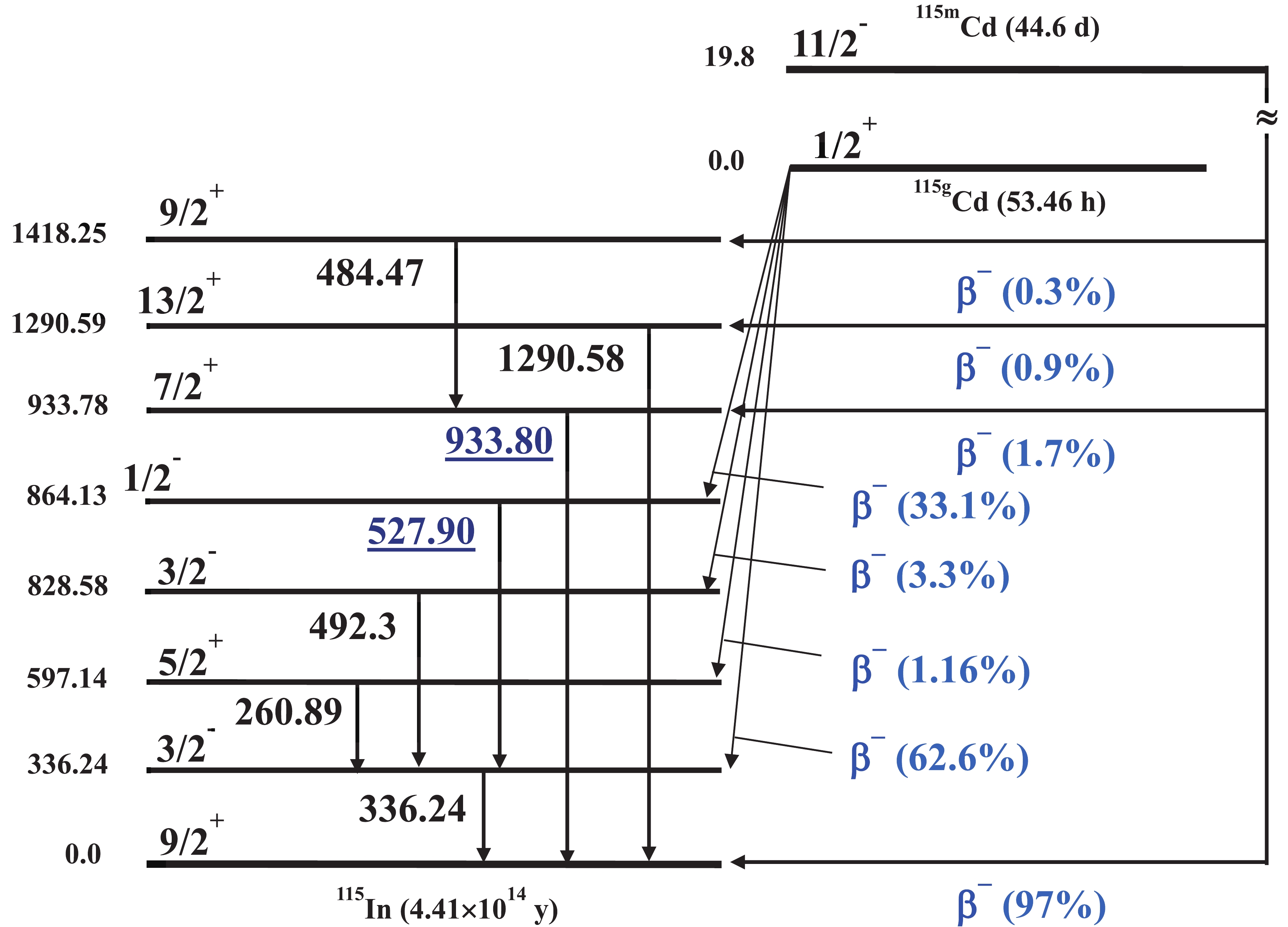 Figure3. (color online) Simplified decay scheme of the 115g,,mCd isomers.
Figure3. (color online) Simplified decay scheme of the 115g,,mCd isomers.The measured results for the natCd(γ, xn)115g;115mCd reactions are compared with the theoretical values obtained with the TALYS-1.95 and Empire 3.2 codes, as shown in Fig. 4. There is no literature data for the natCd(γ, xn)115gCd reaction. It is clear that the theoretical values from both the TALYS-1.95 and Empire 3.2 codes are in agreement with the data from this study, as shown in Fig. 4. However, there is only one set of literature data regarding the low energy side of the GDR region for the natCd(γ, xn)115mCd reaction [8], which was obtained with mono-energetic photons. To compare those results with the results of this study, we calculated the flux-weighted average cross section for the literature value using Eq. (7), as shown in Fig. 4. The flux-weighted average cross sections for literature data in the low energy region were higher than the theoretical results. However, the present results are lower than the values obtained with the TALYS-1.95 and Empire 3.2 codes, as shown in Fig. 4.
 Figure4. (color online) The experimental flux-weighted average cross sections of natCd(γ, xn)115gCd and natCd(γ, xn)115mCd reactions as a function of bremsstrahlung end-point energy along with the theoretical calculations using the TALYS-1.95 and EMPIRE-3.2 codes.
Figure4. (color online) The experimental flux-weighted average cross sections of natCd(γ, xn)115gCd and natCd(γ, xn)115mCd reactions as a function of bremsstrahlung end-point energy along with the theoretical calculations using the TALYS-1.95 and EMPIRE-3.2 codes.Based on the measured experimental cross sections of the metastable and ground states from Table 4, we obtained the isomeric yield ratio (IR=σh/σl) of 115gCd (nuclear spin=1/2+) and 115mCd (nuclear spin=11/2-) in the natCd(γ, xn) reactions, which are given in Table 5 for various bremsstrahlung end-point energies. The photon-induced IR values from this study, the literature data in the GDR region [11-14], and our previous results [15] are listed in Table 5 and shown in Fig. 5. The IR values for neutron-induced 116Cd(n, 2n)115g,mCd reactions taken from previous data [16] and those theoretically calculated using TALYS-1.95, EMPIRE-3.2 Malta, and TENDL-2019 [26] are also presented in Table 5 and Fig. 5.
| Reaction | Projectile energy/MeV | Excitation energy/MeV | Isomeric ratio (  | ||
| Experimental work [Ref.] | Theoretical calculations | ||||
| TALYS 1.95 [17] | Empire 3.2 Malta [18] | ||||
| natCd(γ, xn)115g,mCd | 50 | 13.922 | 0.206 ± 0.041 [A] | 0.212 | 0.214 |
| 60 | 13.928 | 0.210 ± 0.038 [A] | 0.212 | 0.214 | |
| 116Cd(γ, n)115gmCd | 9.43 | 9.072 | 0.180 ± 0.019 [12] | 0.015 | 0.004 |
| 116Cd(γ, n)115g,mCd | 20 | 13.803 | 0.117 ± 0.012 [14] | 0.205 | 0.213 |
| 116Cd(γ, n)115g,mCd | 20 | 13.803 | 0.148 ± 0.020 [11] | 0.205 | 0.214 |
| 116Cd(γ, n)115g,mCd | 22 | 13.841 | 0.120 ± 0.020 [13] | 0.209 | 0.214 |
| 116Cd(γ, n)115g,mCd | 23.5 | 13.857 | 0.158 ± 0.016 [14] | 0.209 | 0.214 |
| 116Cd(γ, n)115g,mCd | 50 | 13.922 | 0.186 ± 0.020 [15] | 0.212 | 0.214 |
| 116Cd(γ, n)115g,mCd | 60 | 13.928 | 0.202 ± 0.020 [15] | 0.212 | 0.214 |
| 116Cd(γ, n)115g,mCd | 70 | 13.933 | 0.209 ± 0.019 [15] | 0.212 | 0.214 |
| 116Cd(n, 2n)115g,mCd | 13.4 | 19.04 | 0.95 ± 0.13 [16] | 1.321 | 1.189 |
| 116Cd(n, 2n)115g,mCd | 14 | 19.64 | 0.98 ± 0.14 [16] | 1.360 | 1.246 |
| 116Cd(n, 2n)115g,mCd | 14.68 | 20.32 | 1.0 ± 0.14 [16] | 1.398 | 1.295 |
| 116Cd(n, 2n)115g,mCd | 14.81 | 20.45 | 1.05 ± 0.15 [16] | 1.410 | 1.295 |
| 116Cd(n, 2n)115g,mCd | 16.5 | 22.14 | 1.25 ± 0.18 [16] | 1.510 | 1.364 |
| 116Cd(n, 2n)115g,mCd | 17.95 | 23.59 | 1.36 ± 0.19 [16] | 2.810 | 2.690 |
| 116Cd(n, 2n)115g,mCd | 19.76 | 25.40 | 1.59 ± 0.22 [16] | 3.461 | 3.101 |
| [A] Present work. | |||||
Table5.Isomeric yield ratio of 115m,gCd from the 116Cd(γ, n) and 116Cd(n, 2n) reactions.
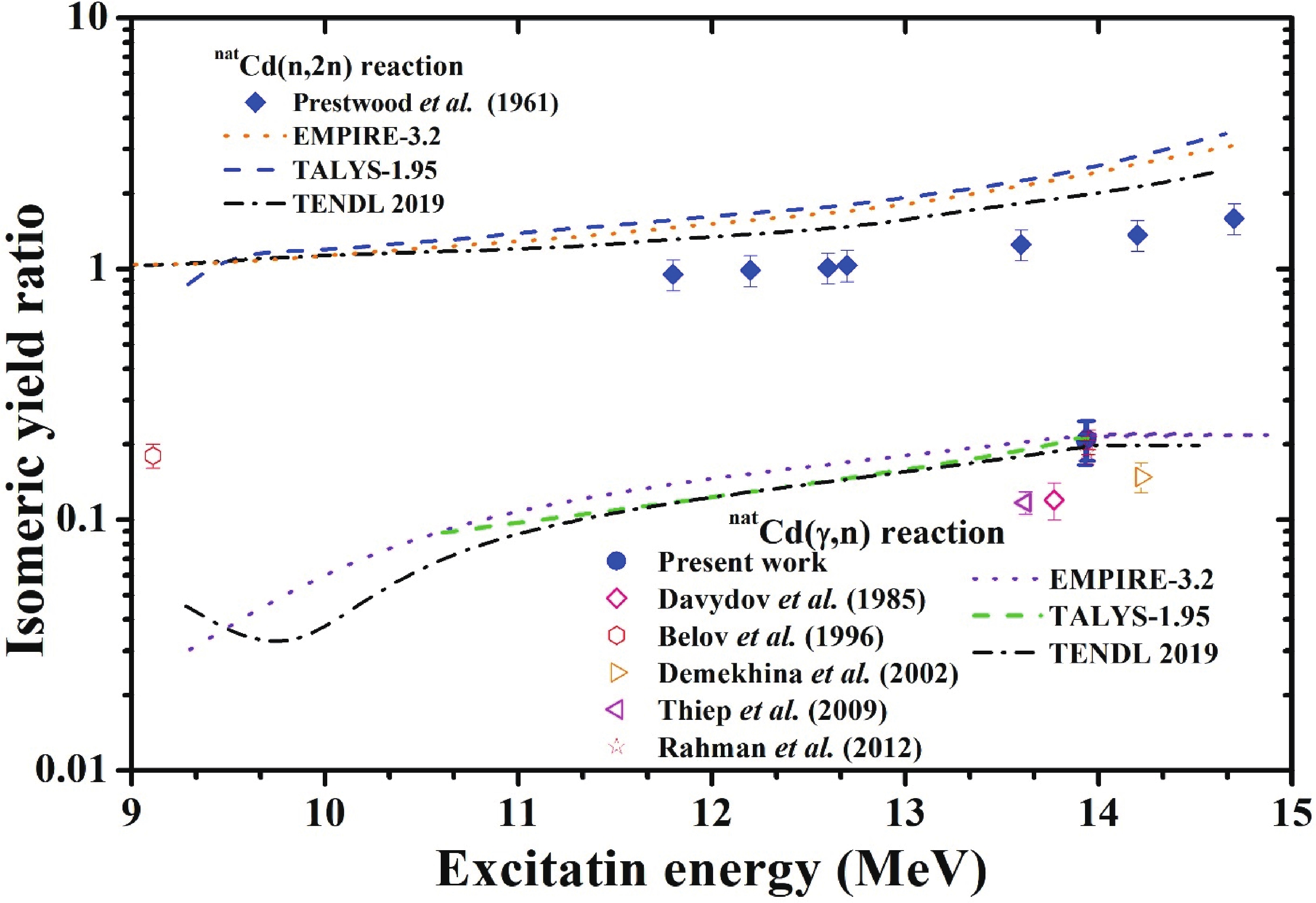 Figure5. (color online) Isomeric cross section ratio (IR=σh/σl) of 115g,mCd in the (γ, n) and (n, 2n) reactions as a function of excitation energy of the compound nucleus.
Figure5. (color online) Isomeric cross section ratio (IR=σh/σl) of 115g,mCd in the (γ, n) and (n, 2n) reactions as a function of excitation energy of the compound nucleus.In order to understand the effects of spin and input angular momentum, outgoing particles, and excitation energy, the IR values from the different reaction channels were compared. The average excitation energy
$\left\langle {{E^*}\left( {{E_{\rm e}}} \right)} \right\rangle = \frac{{\int_{{E_{\rm th}}}^{{E_{\rm e}}} {{\rm{\phi}} \left( E \right){{\rm{\sigma}} _R}\left( E \right)E{\rm d}E} }}{{\int_{{E_{\rm th}}}^{{E_{\rm e}}} {{\rm{\phi}} \left( E \right)} {{\rm{\sigma}} _R}\left( E \right){\rm d}E}},$ | (8) |
The excitation energy (E*) of the compound nucleus in the neutron and charged particle induced reactions was calculated as follows:
${E^*} = {E_{\rm p}} + \left( {{\Delta _{\rm T}}\, + \,{\Delta _{\rm p}}} \right)\, - \,{\Delta _{\rm CN}},$ | (9) |
As seen in Fig. 5, the experimental IR values in the 116Cd(γ, n) reaction are in agreement with the theoretical values. However, in the 116Cd(n, 2n) reaction, the theoretical values from TALYS-1.95, EMPIRE-3.2, and TENDL-2019 are higher than the experimental values. Additionally, in the 116Cd(n, 2n) reaction, the theoretical values from TALYS-1.95 and EMPIRE-3.2 are slightly different. TENDL-2019 data are lower than the TALYS-1.95 data but are close to the experimental data. These differences are due to the use of default parameters in the current calculations with TALYS-1.95. Furthermore, the figure shows that the IR values of 115m,gCd increase with increasing excitation energy. However, at the same excitation energy, the IR values of 115m,gCd in the 116Cd(n, 2n) reaction are significantly higher than those in the 116Cd(γ, n) reaction. In the 116Cd(γ, n) reaction, the compound nucleus is 116Cd*, which has a 0+ spin. On the other hand, in the 116Cd(n, 2n) reaction, the compound nucleus is 117Cd*, which has a 11/2- spin in the excited state and ?+ spin in the ground state. At a high excitation energy, the compound nucleus of 117Cd* with a high spin value of 11/2- will be favorable in the 116Cd(n, 2n) reaction. Thus, the high spin isomeric product 115mCd with a spin state of 11/2- will preferably be populated in the 116Cd(n, 2n) reaction, which results in a high IR value. This observation indicates the role of the spin of a compound nucleus alongside excitation energy. A similar observation can be made from our previous studies on the isomer ratio of 106m,gAg and 104m,gAg from the natAg (γ, xn) [30] and natAg(n, xn) [28] reactions, which support our present observations.
3
2.natCd(γ, xn)111mCd reaction
The isomeric state 111mCd (48.5 min, 11/2+) was identified by the pure and independent 245.39 keV γ-line. For the production of 111mCd from the 112Cd target, only two previous experimental data sets in the GDR energy region based on mono-energetic photons were available [8, 9]; these were found to be higher than the theoretical values obtained using the TALYS-1.95 and EMPIRE-3.2 Malta codes as shown in Fig. 6 and provided in Table 4. The figure and table also show that the current results follow the graphical shape but are higher than the theoretical values; they are the closest to the values calculated using the Empire-3.2 code.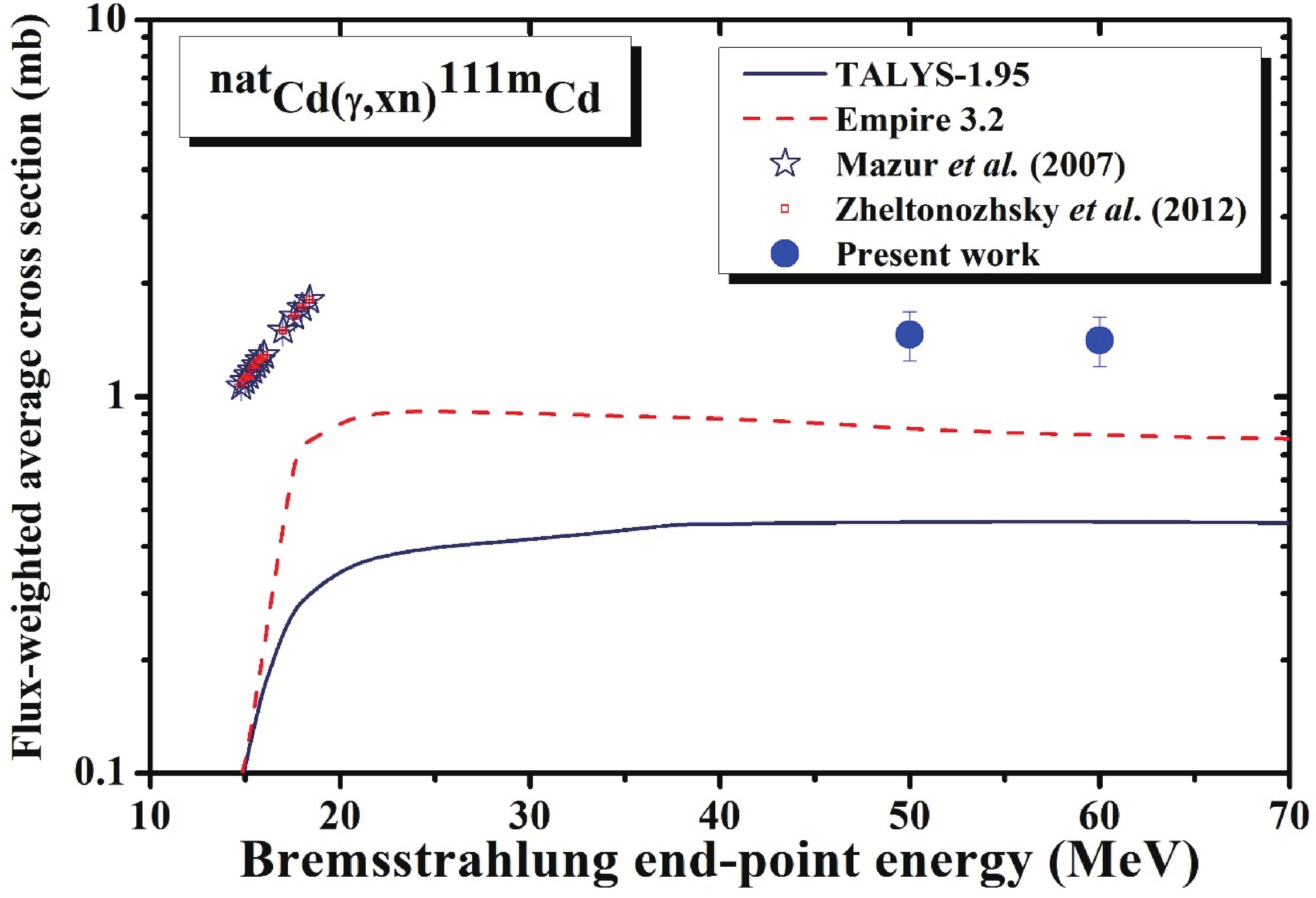 Figure6. (color online) Experimental flux-weighted average cross sections of the natCd(γ, xn)111mCd reaction as a function of bremsstrahlung end-point energy along with the theoretical calculations using the TALYS-1.95 and EMPIRE-3.2 codes.
Figure6. (color online) Experimental flux-weighted average cross sections of the natCd(γ, xn)111mCd reaction as a function of bremsstrahlung end-point energy along with the theoretical calculations using the TALYS-1.95 and EMPIRE-3.2 codes.3
3.natCd(γ, xn)109Cd reaction
The radionuclide 109Cd (461.9 d, 5/2+) was identified by the pure and independent 88.03 keV γ-line. The measured natCd(γ, xn)109Cd reaction cross-sections could onlybe compared with the theoretical calculations because no previous data has been found, as shown in Fig. 7 and tabulated in Table 4. In the figure, it is clear that the currently measured and theoretical values are in good agreement, in terms of not only shape but also magnitude.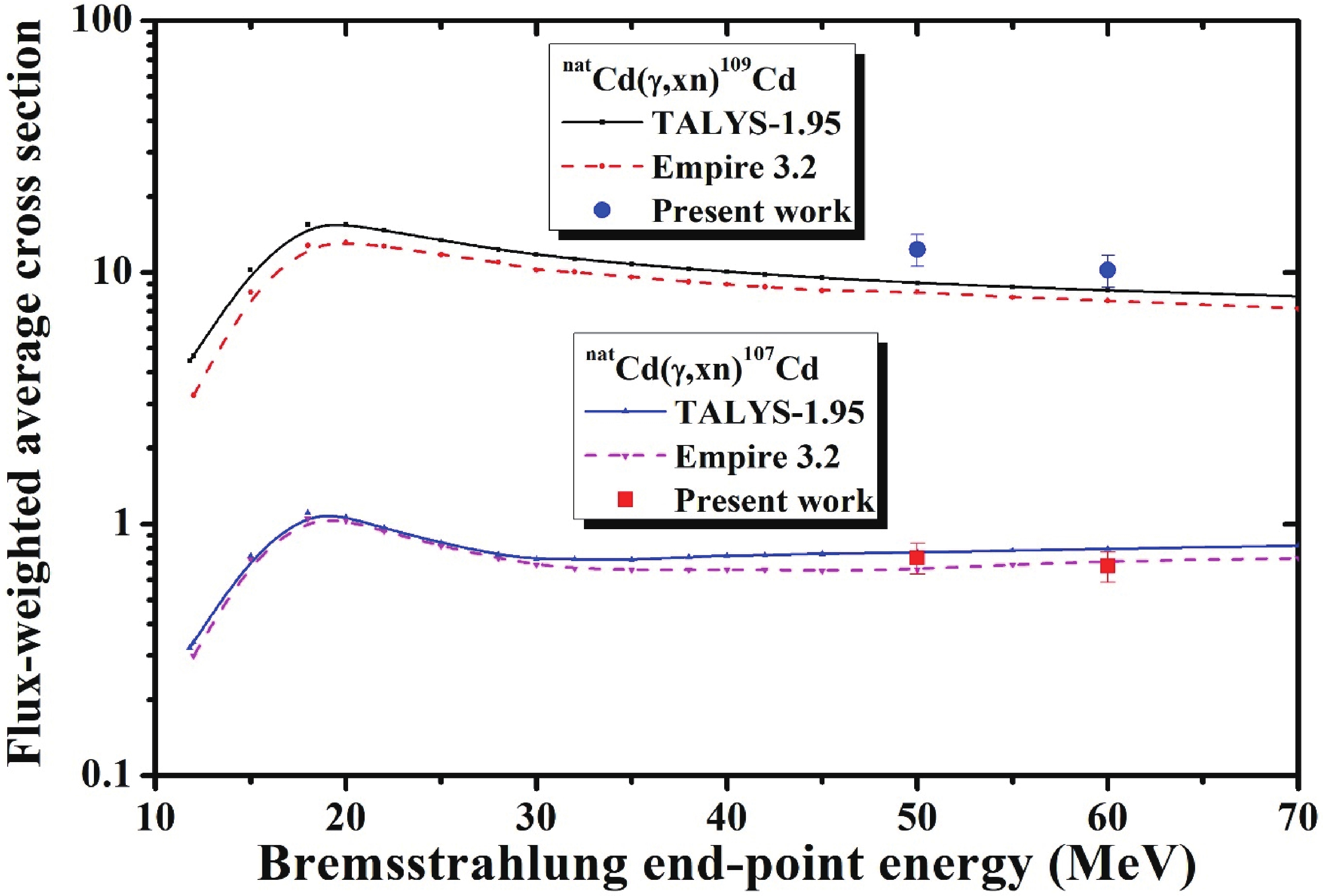 Figure7. (color online) Experimental flux-weighted average cross sections of the natCd(γ, xn)109Cd and natCd(γ, xn)107Cd reactions as a function of bremsstrahlung end-point energy along with the theoretical calculations using the TALYS-1.95 and EMPIRE-3.2 codes.
Figure7. (color online) Experimental flux-weighted average cross sections of the natCd(γ, xn)109Cd and natCd(γ, xn)107Cd reactions as a function of bremsstrahlung end-point energy along with the theoretical calculations using the TALYS-1.95 and EMPIRE-3.2 codes.3
4.natCd(γ, xn)107Cd reactions
The flux-weighted average formation cross sections of 107Cd (6.5 h, 5/2+) were measured based on the 93.12 keV γ line. The measurements for the natCd(γ, xn)107Cd reaction were performed for the first time and thus could only be compared with the theoretical values. Fig. 7 shows that the measurements are in good agreement with both of the calculations, but they are closer to the EMPIRE-3.2 Malta calculations.3
5.natCd(γ, xn)105Cd reactions
The flux-weighted average formation cross sections for 105Cd (55.5 min, 5/2+) were measured based on the independent 961.84 keV γ-line. The radioisotope (105Cd) is without an isomer. For this reaction, no literature data were available; hence, its measurements were also only compared with the theoretical calculations. In Fig. 8 and Table 4, it is clear that the flux-weighted average reaction cross sections calculated by the EMPIRE-3.2 Malta and TALYS-1.95 codes are almost the same, but they are higher than the currently presented results for the natCd(γ, xn)105Cd reaction.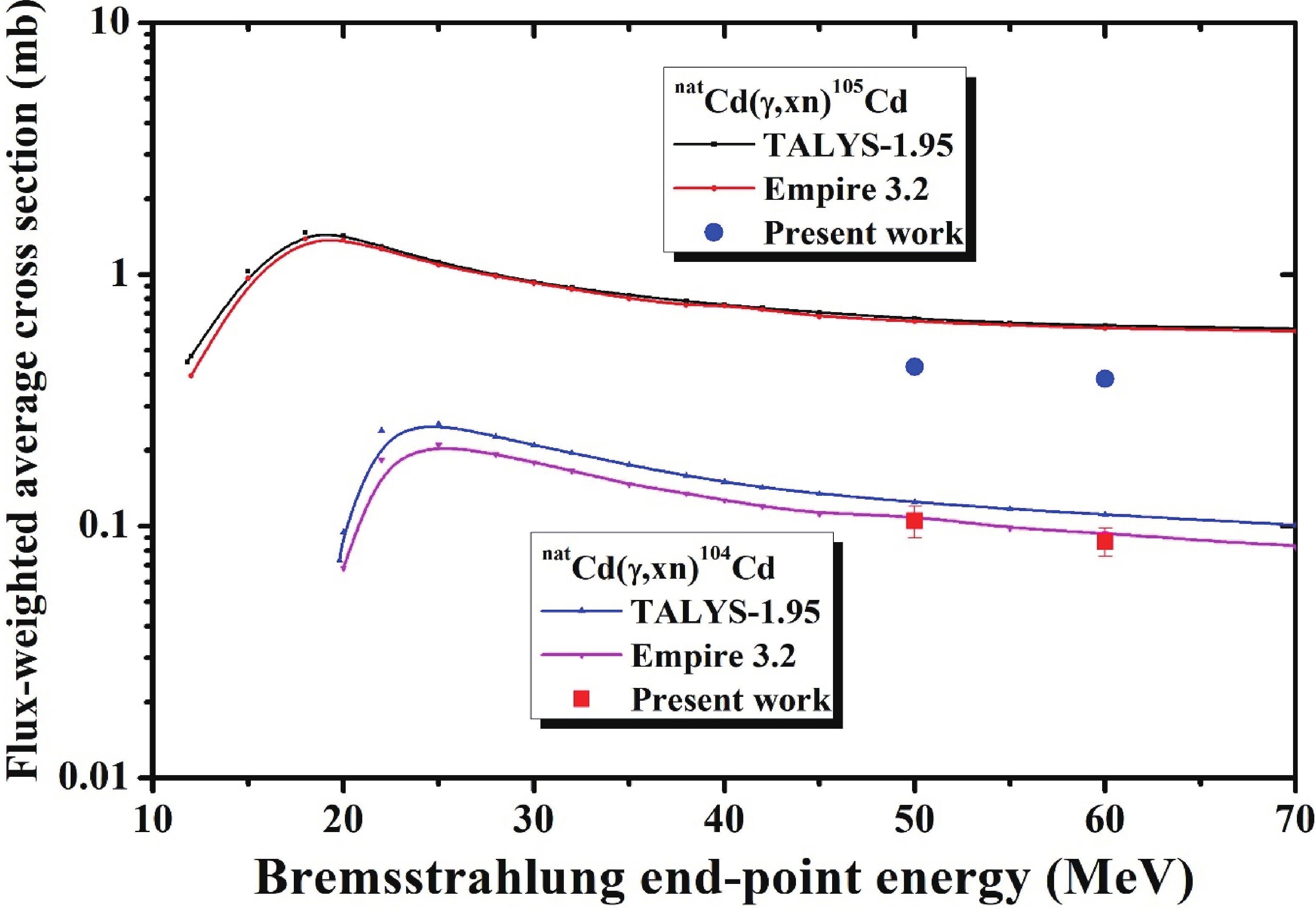 Figure8. (color online) Experimental flux-weighted average cross sections of the natCd(γ, xn)105Cd and natCd(γ, xn)104Cd reactions as a function of bremsstrahlung end-point energy along with the theoretical calculations using the TALYS-1.95 and EMPIRE-3.2 codes.
Figure8. (color online) Experimental flux-weighted average cross sections of the natCd(γ, xn)105Cd and natCd(γ, xn)104Cd reactions as a function of bremsstrahlung end-point energy along with the theoretical calculations using the TALYS-1.95 and EMPIRE-3.2 codes.3
6.natCd(γ, xn)104Cd reaction
The flux-weighted average formation cross section measurements of 104Cd (57.7 min, 0+) were also performed based onthe independent 83.5 keV γ-line. This reaction was studied for the first time and thus could only be compared with the theoretical values. In Table 4 and Fig. 8, the measured cross sections for the natCd(γ, xn)104Cd reaction are shown to be in good agreement with both calculations in terms of shape and magnitude, but they are more precisely matched with the EMPIRE-3.2 Malta calculations.2
B.Measured reaction cross-sections of silver radionuclides
Radioisotopes of silver (113g,112,111g,110mAg) were formed directly through (γ, pxn) reactions. During theirdirect production, 113gAg and 111gAg were populated by their short-lived metastable states by isomeric transition (IT). Therefore, their reaction cross sections were considered as cumulative values. 112Ag has no isomer, while 110mAg has no contribution from any other radioisotope for its production; hence, their formation cross sections are exclusive and independent. Further details on silver residual nuclides are given below.3
1.Cumulative natCd(γ, pxn)113gAg reaction
The deduced cumulative formation cross sections of 113gAg (5.37 h, 1/2-) include the direct production and the production through decay of the short-lived isomeric state 113mAg (62 s, 7/2+), as presented in Fig. 9 and listed in Table 4. Measurements of the natCd(γ, pxn)113gAg reaction cross sections were performed using the 298.6 keV γ-line. Moreover, it is important to note that the production probability of the meta-stable state is low due to its high spin state (7/2+); therefore, we may conclude that 113mAg has a low contribution to the cumulative formation cross section of 113gAg. The measurements from the reaction were only compared with the theoretical values due to unavailability of published data. In Fig. 9(a), it is shown that the measured values for the reaction are higher than the calculated values; however, they exhibit the same tendency as the incident photon energy increases. Figure9. (color online) Experimental flux-weighted average cross sections of the (a) natCd(γ, x)113gAg and (b) natCd(γ, xn)112Ag reactions as a function of bremsstrahlung end-point energy along with the theoretical calculations using the TALYS-1.95 and EMPIRE-3.2 codes.
Figure9. (color online) Experimental flux-weighted average cross sections of the (a) natCd(γ, x)113gAg and (b) natCd(γ, xn)112Ag reactions as a function of bremsstrahlung end-point energy along with the theoretical calculations using the TALYS-1.95 and EMPIRE-3.2 codes.3
2.natCd(γ, pxn)112Ag reaction
The natCd(γ, pxn)112Ag reaction cross-sections were measured based on the 617.52 keV γ-line of 112Ag (3.13 h, 2-). This γ-line is also contributed to by 105Cd and 106mAg. However, after separating the contributions, it was found that their combined contribution to the 617.52 keV γ-line was only ~2%-3%, and thus, they were added to the photo peak area uncertainty. These measurements were only compared with the theoretical values due to unavailability of published data. In Fig. 9(b) and Table 4, the measured values are revealed to be higher than the calculated values; however, both follow a similar trend when the incident photon energy is increased. Moreover, the magnitude of the current measurements are shown to be closer to the EMPIRE-3.2 calculation than the TALYS calculation.3
3.Cumulative natCd(γ, pxn)111gAg reaction
For measurements of the flux-weighted average production cross section of 111gAg (7.45 d, 1/2-), the situation is the same as in the previous case with (113gAg). It is formed directly via the (γ, pxn) reaction and through the IT (99.3%) decay of the simultaneously produced short-lived 111mAg (1.08 min, 7/2+). In this case,the nuclear spin of the metastable state is higher; hence, its production probability is lower than that of the ground state. Based on this, we may once again conclude that the cumulative cross section measurements of 111gAg have a low 111mAg decay contribution. A comparison of the present results with theoretical values is shown in Fig. 10(a) and Table 4.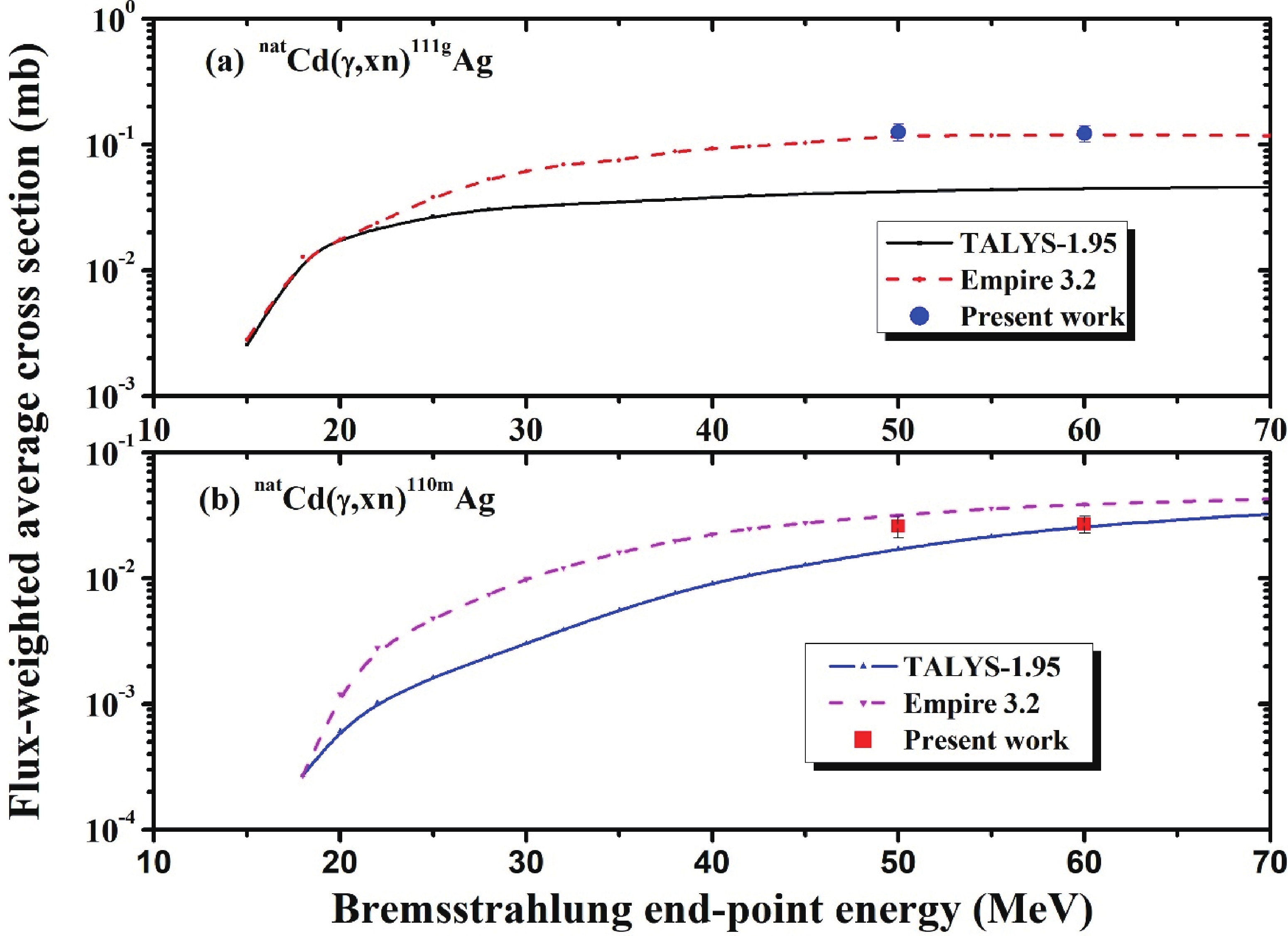 Figure10. (color online) Experimental flux-weighted average cross sections of the (a) natCd(γ, xn)111gAg and (b) natCd(γ, xn)110mAg reactions as a function of bremsstrahlung end-point energy along with the theoretical calculations using the TALYS-1.95 and EMPIRE-3.2 codes.
Figure10. (color online) Experimental flux-weighted average cross sections of the (a) natCd(γ, xn)111gAg and (b) natCd(γ, xn)110mAg reactions as a function of bremsstrahlung end-point energy along with the theoretical calculations using the TALYS-1.95 and EMPIRE-3.2 codes.3
4.natCd(γ, pxn)110mAg reaction
Flux-weighted average production cross sections of 110mAg (249.83 d, 6+) were measured based on the 657.76 keV γ-line. The gamma-ray spectrum was taken after sufficient time had passed to ensure other short-lived nuclides such as 105Cd, which contaminate the 657.76 keV γ-line, had sufficiently decayed. The measured results, along with the calculated values, are shown in Fig. 10(b) and listed in Table 4. Both of the results are consistent and higher than the theoretical values but closer to the values calculated using the EMPIRE-3.2 code.2
C.Integrated yield (Bq/g.μAh)
The production of cadmium and silver isotopes are important for medical and industrial applications and for a better understanding of their production in photon induced nuclear reactions. Therefore, the integrated yields (Bq/g.μAh) of cadmium and silver isotope productions from natCd(γ, x) reactions were measured in a procedure similar to that used for the integral yields of rhodium isotopes from the 103Rh(γ, x) reaction [19, 31]. The integral yields of cadmium and silver isotope productions from natCd(γ, x) reactions are given in Table 6.| Reaction | Isotope | Yields/(Bq/g·A·h) | |
| Bremsstrahlung end-point energy/MeV | |||
| 50 | 60 | ||
| natCd(γ, xn)115gCd | 115gCd | (8.83±0.57)×106 | (8.52±0.60)×107 |
| natCd(γ, xn)115mCd | 115mCd | (1.86±0.12)×106 | (1.80±0.19)×107 |
| natCd(γ, xn)111mCd | 111mCd | (4.48± 0.28)×106 | (8.99±0.61)×107 |
| natCd(γ, xn)109Cd | 109Cd | (3.62±0.26)×107 | (2.49±0.21)×108 |
| natCd(γ, xn)107Cd | 107Cd | (1.71±0.12)×106 | (1.73± 0.12)×107 |
| natCd(γ, xn)105Cd | 105Cd | (1.44±0.13)×106 | (1.17±0.14)×107 |
| natCd(γ, xn)104Cd | 104Cd | (1.8±0.12)×105 | (1.73±0.15)×106 |
| natCd(γ, pxn)113g+mAg | 113m+gAg | (1.58±0.11)×106 | (1.67±0.11)×107 |
| natCd(γ, pxn)112Ag | 112Ag | (7.0±0.41)×105 | (8.74±0.53)×106 |
| natCd(γ, pxn)111g+mAg | 111gAg | (3.3±0.24)×105 | (3.55±0.32)×106 |
| natCd(γ, pxn)110mAg | 110mAg | (6.0±0.65)×104 | (5.6±0.40)×105 |
Table6.Integral isotopic yield of different products from the natCd(γ, xn) and natCd(γ, pxn) reactions.
